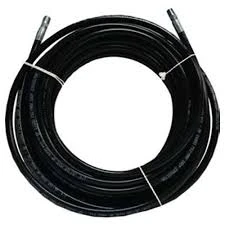Effective Techniques for Bleeding Brake Lines with a Flexible Tube System
Understanding Brake Bleeding Tubes A Crucial Aspect of Vehicle Maintenance
Brake bleeding tubes play an essential role in maintaining a vehicle’s braking system. The braking system is arguably one of the most critical safety features in any vehicle, and ensuring it functions correctly is paramount for driver and passenger safety. In this article, we will explore what brake bleeding tubes are, how they work, and the importance of proper brake maintenance.
What Are Brake Bleeding Tubes?
Brake bleeding tubes are specialized hoses designed to remove air bubbles from the brake lines of a vehicle. During the brake bleeding process, these tubes facilitate the expulsion of old brake fluid and air trapped in the brake lines. Air in the brake lines can lead to a spongy brake pedal feel and, ultimately, reduced braking efficiency, which can be dangerous.
How Does The Bleeding Process Work?
The process of bleeding the brakes usually involves several steps, which can vary slightly depending on the vehicle make and model. Here’s a generalized overview of the procedure
1. Preparation Start by gathering necessary tools, including a wrench to fit the brake bleeder screw, brake fluid, and the bleeding tubes. It’s also important to have a helper, as the procedure often requires someone to pump the brake pedal while another person manages the bleeding process.
2. Locate the Brake Bleeder Valve Each brake caliper or wheel cylinder has a bleed valve, typically found on the top of the caliper. This valve allows air and old fluid to escape when opened.
3. Attach the Brake Bleeding Tube The next step involves attaching one end of the bleeding tube to the bleeder valve and placing the other end into a container that will catch the fluid. This prevents spillage and keeps the workspace tidy.
brake bleeding tube

4. Bleeding the Brakes With the tube in place, the helper pumps the brake pedal several times and holds it down. The valve is then opened, allowing air and fluid to escape through the tube. Once fluid begins to flow without bubbles, the valve is closed, and the helper can release the brake pedal.
5. Repeat as Necessary This process is typically repeated for each wheel, often starting from the furthest wheel from the master cylinder (usually the back-right wheel) and moving closer (back-left, front-right, front-left).
6. Check Fluid Levels It’s crucial to constantly monitor the brake fluid level in the master cylinder reservoir, adding more fluid as necessary to ensure it doesn’t run dry during the bleeding process.
The Importance of Brake Maintenance
Regular brake maintenance, including bleeding the brakes, is essential for vehicle safety. Over time, brake fluid can absorb moisture, leading to reduced boiling points and increased risk of brake failure. By using brake bleeding tubes and ensuring that the brake lines are free of air, drivers can maintain a firmer brake pedal feel and optimal braking performance.
In addition to safety, regular maintenance can extend the lifespan of brake components, saving money on repairs and replacements in the long run. Neglecting brake maintenance can lead to more severe issues, including brake system failure, which can have catastrophic consequences on the road.
Conclusion
Brake bleeding tubes are a small yet crucial component in the brake maintenance process. Proper use of these tubes ensures air is effectively removed from the brake system, allowing for safer and more reliable vehicle operation. As responsible vehicle owners, it's imperative to stay on top of brake maintenance to preserve the safety of our vehicles and those of others on the road. Whether performed by a professional or as a DIY project at home, ensuring that your vehicle’s braking system is in optimal condition is a fundamental part of vehicle ownership.
-
Ultimate Spiral Protection for Hoses & CablesNewsJun.26,2025
-
The Ultimate Quick-Connect Solutions for Every NeedNewsJun.26,2025
-
SAE J1401 Brake Hose: Reliable Choice for Safe BrakingNewsJun.26,2025
-
Reliable J2064 A/C Hoses for Real-World Cooling NeedsNewsJun.26,2025
-
Heavy-Duty Sewer Jetting Hoses Built to LastNewsJun.26,2025
-
Fix Power Steering Tube Leaks Fast – Durable & Affordable SolutionNewsJun.26,2025

